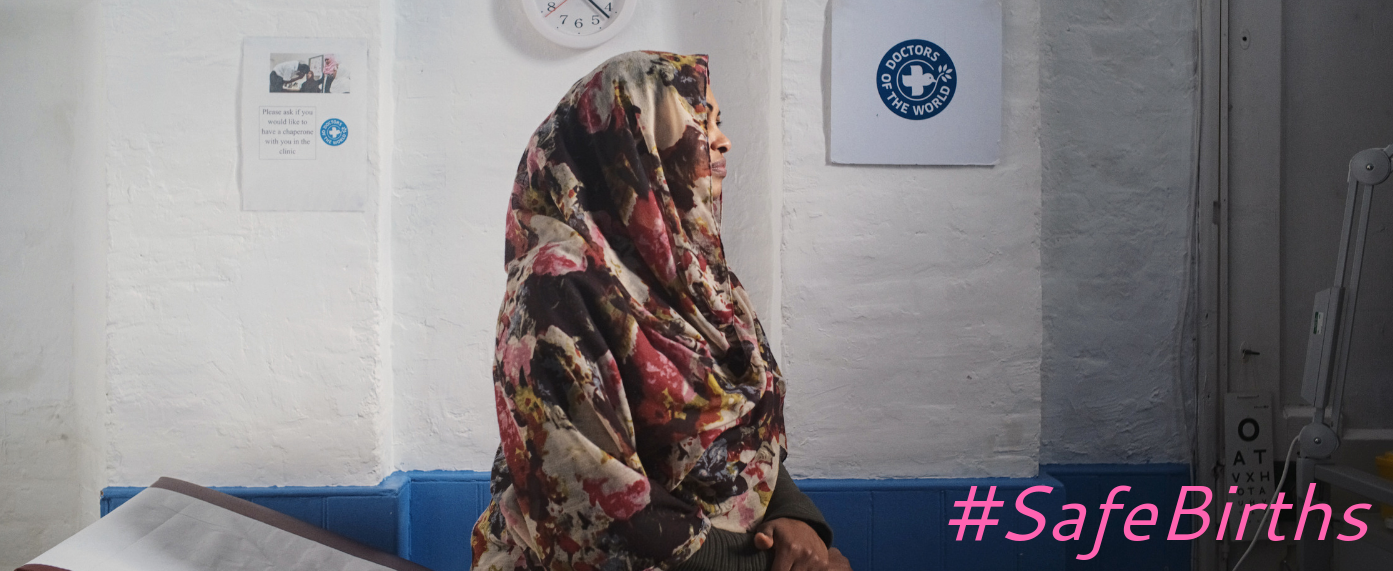Day One #SafeBirths – Bettina
Published 23rd November 2018
The Women and Children’s Clinic – A Midwife’s Perspective
Bettina is a volunteer midwife at the Women and Children’s Clinic in our London Clinic. She is a qualified midwife and has been with Doctors of the World for a number of years.
As a midwife the fact that the simplest definition of the word is to be “with woman” means a lot to me. It was a key factor in my decision to choose midwifery as a career and to this day prospective midwifery students will probably not get a training place unless they mention “women-centered care” a couple of times during their interview.
I started working as a midwife full of enthusiasm but after fourteen years in a maternity setting, I was exhausted and disillusioned. I found it increasingly difficult to simultaneously support two (and sometimes three) women in labor or feel I had given adequate care on the postnatal ward which, when full, housed 24 new mothers and an equal number of babies.
I bailed out, did a Master’s degree and then worked as a research assistant in a teaching hospital. However, something stopped me from relinquishing my midwifery qualification and I continued with the mandatory training and the required number of practice hours, working part-time as a midwife in the antenatal clinic.
I had been volunteering with Doctors of the World for some years when in 2014 we started the Women and Children’s Clinic to respond to the large number of pregnant women and families arriving at the Bethnal Green Clinic. It seemed natural to me to gravitate towards this new clinic.
At the DOTW clinic, midwives practice in an advisory capacity rather than a clinical one. Although it initially felt a little strange not being able to do blood pressures or abdominal palpations, I have always felt that the essence of good midwifery has less to do with the physical aspects of the job and more to do with the midwife’s responsibility to protect, nurture and care for mothers and babies.
Caring is what we do best at the Women and Children’s Clinic, especially caring for the often vulnerable and destitute Black, Asian, Ethnic Minority (BAME), women, mostly from migrant or refugee backgrounds, who form the majority of people coming through the door. These women have remained hidden from both voluntary and statutory services until pregnancy forces them to seek help to access NHS maternity care.
Unfortunately, the NHS fails these women to a large extent. For one, there is the looming presence of maternity care charges that many vulnerable migrant and asylum-seeking women are subjected to. Time and time again we see pregnant women at the clinic who delay accessing or avoid visiting hospitals altogether for fear of incurring huge debts that they cannot pay. There is also a very real fear that having an unpaid maternity care debt will result in being reported to the Home Office. NHS charges maternity care in England -inflated to 150% of the NHS tariff- are truly exorbitant.
Nowadays, bills of £6000 for the basic maternity package (i.e. for an uncomplicated pregnancy and delivery) are the norm. Often they are much higher. One of the more shocking cases I recently dealt with concerns a lady who was sent a bill of £9600 soon after her 22 week miscarriage.
Midwives are taught that it is the pregnant woman who should be the focus of maternity care, that the woman should be able to feel that she is in control of what is happening to her and be able to make decisions about her own care and needs. As a midwife, you can’t help but notice the stark contrast between the typical maternity journey of a British woman, who will generally be in the driver’s seat with an understanding of the principles of choice and control which underpin antenatal care with that of the migrant women who come to DOTW, often with little English and knowledge of their rights, will be very different. Frequently, our service users attend the clinic in the second or even third trimester of their pregnancy and have never heard the baby’s heart beat.
For many, the prospect of giving birth in the UK is one of stress and fear. The pregnant service users that attend the Bethnal Green clinic often cry. A feature of the clinic are the strategically placed boxes of tissues which need frequent replacing.
Apart from a place where there is literally a shoulder to cry on, our Women and Children’s clinic supports pregnant service users in many ways. Volunteers try to assist migrant women overcome the barriers they experience when accessing maternity services. They signpost them to debt management charities when the maternity care bill lands on the mat. Most importantly, they communicate with the service user in their first language, using phone interpreting services.
Apart from all of that, there are two key things that make the Women and Children’s Clinic such a special service and unfortunately our patients often can’t get them elsewhere: the use of interpreters and the flexible time allowed for consultations. I’ve seen how in some NHS hospitals, interpreters are only rarely or inconsistently used, meaning that mother and midwife struggle to communicate. As for time, it is so important to be able to take those extra moments with a mother traumatised by a previous birth experience, or with a woman confused about pain relief in labour – a honest, empathetic conversation always wins over a leaflet, however well designed.
It is because I know I have the time to care at the Women and Children’s Clinic that you will find me most Tuesdays on the Central Line heading to Bethnal Green. I know that at the clinic I can truly be “with woman”; that I can be a midwife.
Read also:
